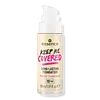What's inside
What's inside
 Key Ingredients
Key Ingredients

 Benefits
Benefits

 Concerns
Concerns

 Ingredients Side-by-side
Ingredients Side-by-side

Water
Skin ConditioningPolyglyceryl-6 Polyricinoleate
EmulsifyingCoconut Alkanes
EmollientCaprylyl Methicone
Skin ConditioningCetearyl Isononanoate
EmollientPolyglyceryl-2 Isostearate
EmulsifyingGlycerin
HumectantDisteardimonium Hectorite
StabilisingBoron Nitride
AbsorbentDimethicone
EmollientSodium Chloride
MaskingGlyceryl Caprylate
EmollientSilica
AbrasiveCoco-Caprylate/Caprate
EmollientSodium Dehydroacetate
PreservativeLevulinic Acid
PerfumingSodium Levulinate
Skin ConditioningTriethoxycaprylylsilane
Tocopherol
AntioxidantVitis Vinifera Seed Oil
EmollientSqualane
EmollientHelianthus Annuus Seed Oil
EmollientSodium Phytate
Water, Polyglyceryl-6 Polyricinoleate, Coconut Alkanes, Caprylyl Methicone, Cetearyl Isononanoate, Polyglyceryl-2 Isostearate, Glycerin, Disteardimonium Hectorite, Boron Nitride, Dimethicone, Sodium Chloride, Glyceryl Caprylate, Silica, Coco-Caprylate/Caprate, Sodium Dehydroacetate, Levulinic Acid, Sodium Levulinate, Triethoxycaprylylsilane, Tocopherol, Vitis Vinifera Seed Oil, Squalane, Helianthus Annuus Seed Oil, Sodium Phytate
Water
Skin ConditioningIsododecane
EmollientC13-15 Alkane
SolventPolyglyceryl-4 Diisostearate/Polyhydroxystearate/Sebacate
EmulsifyingC12-15 Alkyl Benzoate
AntimicrobialZinc Stearate
Cosmetic ColorantPropanediol
SolventMagnesium Sulfate
Pentylene Glycol
Skin ConditioningTocopherol
AntioxidantEthylene Brassylate
Masking1,2-Hexanediol
Skin ConditioningDisteardimonium Hectorite
StabilisingCaprylhydroxamic Acid
Silica
AbrasiveLecithin
EmollientPropylene Carbonate
SolventStearic Acid
CleansingSodium Chloride
MaskingAscorbyl Palmitate
AntioxidantAluminum Starch Octenylsuccinate
AbsorbentCitric Acid
BufferingCI 77491
Cosmetic ColorantCI 77492
Cosmetic ColorantCI 77499
Cosmetic ColorantCI 77891
Cosmetic ColorantWater, Isododecane, C13-15 Alkane, Polyglyceryl-4 Diisostearate/Polyhydroxystearate/Sebacate, C12-15 Alkyl Benzoate, Zinc Stearate, Propanediol, Magnesium Sulfate, Pentylene Glycol, Tocopherol, Ethylene Brassylate, 1,2-Hexanediol, Disteardimonium Hectorite, Caprylhydroxamic Acid, Silica, Lecithin, Propylene Carbonate, Stearic Acid, Sodium Chloride, Ascorbyl Palmitate, Aluminum Starch Octenylsuccinate, Citric Acid, CI 77491, CI 77492, CI 77499, CI 77891
 Reviews
Reviews

Ingredients Explained
These ingredients are found in both products.
Ingredients higher up in an ingredient list are typically present in a larger amount.
Disteardimonium Hectorite comes from the clay mineral named hectorite. It is used to add thickness to a product.
It can also help stabilize a product by helping to disperse other ingredients.
Hectorite is a rare, white clay mineral.
Learn more about Disteardimonium HectoriteSilica, also known as silicon dioxide, is a naturally occurring mineral. It is used as a fine, spherical, and porous powder in cosmetics.
Though it has exfoliant properties, the function of silica varies depending on the product.
The unique structure of silica enhances the spreadability and adds smoothness, making it a great texture enhancer.
It is also used as an active carrier, emulsifier, and mattifier due to its ability to absorb excess oil.
In some products, tiny microneedles called spicules are made from silica or hydrolyzed sponge. When you rub them in, they lightly polish away dead skin layers and enhance the penetration of active ingredients.
Learn more about SilicaChances are, you eat sodium chloride every day. Sodium Chloride is also known as table salt.
This ingredient has many purposes in skincare: thickener, emulsifier, and exfoliator.
You'll most likely find this ingredient in cleansers where it is used to create a gel-like texture. As an emulsifier, it also prevents ingredients from separating.
There is much debate on whether this ingredient is comedogenic. The short answer - comedogenic ratings don't tell the whole story. Learn more about comegodenic ratings here.
The concensus about this ingredient causing acne seems to be divided. Research is needed to understand if this ingredient does cause acne.
Scrubs may use salt as the primary exfoliating ingredient.
Learn more about Sodium ChlorideTocopherol (also known as Vitamin E) is a common antioxidant used to help protect the skin from free-radicals and strengthen the skin barrier. It's also fat soluble - this means our skin is great at absorbing it.
Vitamin E also helps keep your natural skin lipids healthy. Your lipid skin barrier naturally consists of lipids, ceramides, and fatty acids. Vitamin E offers extra protection for your skin’s lipid barrier, keeping your skin healthy and nourished.
Another benefit is a bit of UV protection. Vitamin E helps reduce the damage caused by UVB rays. (It should not replace your sunscreen). Combining it with Vitamin C can decrease sunburned cells and hyperpigmentation after UV exposure.
You might have noticed Vitamin E + C often paired together. This is because it is great at stabilizing Vitamin C. Using the two together helps increase the effectiveness of both ingredients.
There are often claims that Vitamin E can reduce/prevent scarring, but these claims haven't been confirmed by scientific research.
Learn more about TocopherolWater. It's the most common cosmetic ingredient of all. You'll usually see it at the top of ingredient lists, meaning that it makes up the largest part of the product.
So why is it so popular? Water most often acts as a solvent - this means that it helps dissolve other ingredients into the formulation.
You'll also recognize water as that liquid we all need to stay alive. If you see this, drink a glass of water. Stay hydrated!
Learn more about Water